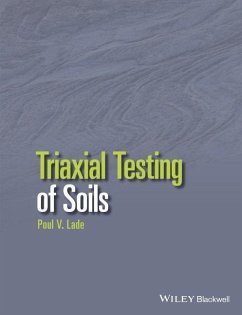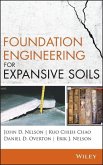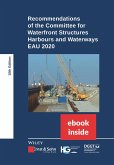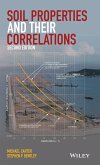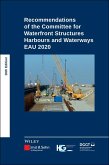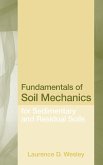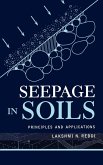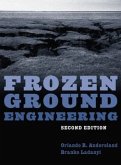Poul V. Lade
Triaxial Testing of Soils
Poul V. Lade
Triaxial Testing of Soils
- Broschiertes Buch
- Merkliste
- Auf die Merkliste
- Bewerten Bewerten
- Teilen
- Produkt teilen
- Produkterinnerung
- Produkterinnerung
Triaxial Testing of Soils explains how to carry out triaxial tests to demonstrate the effects of soil behaviour on engineering designs. An authoritative and comprehensive manual, it reflects current best practice and instrumentation.References are made throughout to easily accessible articles in the literature and the book's focus is on how to obtain high quality experimental results.
Andere Kunden interessierten sich auch für
![Foundation Engineering for Expansive Soils Foundation Engineering for Expansive Soils]() John D. NelsonFoundation Engineering for Expansive Soils139,99 €
John D. NelsonFoundation Engineering for Expansive Soils139,99 €![Recommendations of the Committee for Waterfront Structures Harbours and Waterways. E-Bundle Recommendations of the Committee for Waterfront Structures Harbours and Waterways. E-Bundle]() Recommendations of the Committee for Waterfront Structures Harbours and Waterways. E-Bundle249,00 €
Recommendations of the Committee for Waterfront Structures Harbours and Waterways. E-Bundle249,00 €![Soil Properties and their Correlations Soil Properties and their Correlations]() Michael CarterSoil Properties and their Correlations96,99 €
Michael CarterSoil Properties and their Correlations96,99 €![Recommendations of the Committee for Waterfront Structures Harbours and Waterways Recommendations of the Committee for Waterfront Structures Harbours and Waterways]() Recommendations of the Committee for Waterfront Structures Harbours and Waterways149,00 €
Recommendations of the Committee for Waterfront Structures Harbours and Waterways149,00 €![Fundamental Soil Mechanics Res Fundamental Soil Mechanics Res]() Laurence D. WesleyFundamental Soil Mechanics Res150,99 €
Laurence D. WesleyFundamental Soil Mechanics Res150,99 €![Seepage in Soils Seepage in Soils]() Lakshmi N. ReddiSeepage in Soils172,99 €
Lakshmi N. ReddiSeepage in Soils172,99 €![Frozen Ground Engineering Frozen Ground Engineering]() Orlando B. AnderslandFrozen Ground Engineering185,99 €
Orlando B. AnderslandFrozen Ground Engineering185,99 €-
-
-
Triaxial Testing of Soils explains how to carry out triaxial tests to demonstrate the effects of soil behaviour on engineering designs. An authoritative and comprehensive manual, it reflects current best practice and instrumentation.References are made throughout to easily accessible articles in the literature and the book's focus is on how to obtain high quality experimental results.
Produktdetails
- Produktdetails
- Verlag: Wiley & Sons
- Artikelnr. des Verlages: 1W119106620
- 1. Auflage
- Seitenzahl: 432
- Erscheinungstermin: 2. Mai 2016
- Englisch
- Abmessung: 244mm x 185mm x 15mm
- Gewicht: 902g
- ISBN-13: 9781119106623
- ISBN-10: 1119106621
- Artikelnr.: 44707645
- Herstellerkennzeichnung
- Libri GmbH
- Europaallee 1
- 36244 Bad Hersfeld
- gpsr@libri.de
- Verlag: Wiley & Sons
- Artikelnr. des Verlages: 1W119106620
- 1. Auflage
- Seitenzahl: 432
- Erscheinungstermin: 2. Mai 2016
- Englisch
- Abmessung: 244mm x 185mm x 15mm
- Gewicht: 902g
- ISBN-13: 9781119106623
- ISBN-10: 1119106621
- Artikelnr.: 44707645
- Herstellerkennzeichnung
- Libri GmbH
- Europaallee 1
- 36244 Bad Hersfeld
- gpsr@libri.de
Poul Lade has a career in laboratory experimentation at university level to study and model the behaviour of soils. With his students, the author developed testing equipment, performed experiments and build constitutive models for the observed soil behaviour while a professor at University of California at Los Angeles (UCLA) (1972-1993), Johns Hopkins University (1993-1999), Aalborg University in Denmark (1999-2003), and Catholic University of America in Washington, D.C. (2003-2015). Many of the experimental techniques developed over this range of years are explained in the present book.
Preface xiii
About the Author xvii
1 Principles of Triaxial Testing 1
1.1 Purpose of triaxial tests 1
1.2 Concept of testing 1
1.3 The triaxial test 2
1.4 Advantages and limitations 3
1.5 Test stages - consolidation and shearing 4
1.5.1 Consolidation 5
1.5.2 Shearing 5
1.6 Types of tests 5
1.6.1 Simulation of field conditions 6
1.6.2 Selection of test type 12
2 Computations and Presentation of Test Results 13
2.1 Data reduction 13
2.1.1 Sign rule - 2D 13
2.1.2 Strains 13
2.1.3 Cross-sectional area 23
2.1.4 Stresses 24
2.1.5 Corrections 25
2.1.6 The effective stress principle 25
2.1.7 Stress analysis in two dimensions - Mohr's circle 25
2.1.8 Strain analysis in two dimensions - Mohr's circle 27
2.2 Stress-strain diagrams 28
2.2.1 Basic diagrams 28
2.2.2 Modulus evaluation 37
2.2.3 Derived diagrams 41
2.2.4 Normalized stress-strain behavior 48
2.2.5 Patterns of soil behavior - error recognition 49
2.3 Strength diagrams 51
2.3.1 Definition of effective and total strengths 51
2.3.2 Mohr-Coulomb failure concept 51
2.3.3 Mohr-Coulomb for triaxial compression 54
2.3.4 Curved failure envelope 55
2.3.5 MIT p-q diagram 57
2.3.6 Cambridge p-q diagram 59
2.3.7 Determination of best-fit soil strength parameters 60
2.3.8 Characterization of total strength 60
2.4 Stress paths 61
2.4.1 Drained stress paths 61
2.4.2 Total stress paths in undrained tests 61
2.4.3 Effective stress paths in undrained tests 61
2.4.4 Normalized p-q diagrams 66
2.4.5 Vector curves 68
2.5 Linear regression analysis 72
2.5.1 MIT p-q diagram 72
2.5.2 Cambridge p-q diagram 74
2.5.3 Correct and incorrect linear regression analyses 75
2.6 Three-dimensional stress states 76
2.6.1 General 3D stress states 76
2.6.2 Stress invariants 76
2.6.3 Stress deviator invariants 80
2.6.4 Magnitudes and directions of principal stresses 81
2.7 Principal stress space 83
2.7.1 Octahedral stresses 83
2.7.2 Triaxial plane 84
2.7.3 Octahedral plane 86
2.7.4 Characterization of 3D stress conditions 87
2.7.5 Shapes of stress invariants in principal stress space 89
2.7.6 Procedures for projecting stress points onto a common octahedral plane 90
2.7.7 Procedure for plotting stress points on an octahedral plane 96
2.7.8 Representation of test results with principal stress rotation 97
3 Triaxial Equipment 99
3.1 Triaxial setup 99
3.1.1 Specimen, cap, and base 99
3.1.2 Membrane 103
3.1.3 O-rings 105
3.1.4 Drainage system 106
3.1.5 Leakage of triaxial setup 112
3.1.6 Volume change devices 113
3.1.7 Cell fluid 113
3.1.8 Lubricated ends 120
3.2 Triaxial cell 125
3.2.1 Cell types 125
3.2.2 Cell wall 127
3.2.3 Hoek cell 128
3.3 Piston 128
3.3.1 Piston friction 129
3.3.2 Connections between piston, cap, and specimen 132
3.4 Pressure supply 133
3.4.1 Water column 133
3.4.2 Mercury pot system 134
3.4.3 Compressed gas 135
3.4.4 Mechanically compressed fluids 136
3.4.5 Pressure intensifiers 137
3.4.6 Pressure transfer to triax
About the Author xvii
1 Principles of Triaxial Testing 1
1.1 Purpose of triaxial tests 1
1.2 Concept of testing 1
1.3 The triaxial test 2
1.4 Advantages and limitations 3
1.5 Test stages - consolidation and shearing 4
1.5.1 Consolidation 5
1.5.2 Shearing 5
1.6 Types of tests 5
1.6.1 Simulation of field conditions 6
1.6.2 Selection of test type 12
2 Computations and Presentation of Test Results 13
2.1 Data reduction 13
2.1.1 Sign rule - 2D 13
2.1.2 Strains 13
2.1.3 Cross-sectional area 23
2.1.4 Stresses 24
2.1.5 Corrections 25
2.1.6 The effective stress principle 25
2.1.7 Stress analysis in two dimensions - Mohr's circle 25
2.1.8 Strain analysis in two dimensions - Mohr's circle 27
2.2 Stress-strain diagrams 28
2.2.1 Basic diagrams 28
2.2.2 Modulus evaluation 37
2.2.3 Derived diagrams 41
2.2.4 Normalized stress-strain behavior 48
2.2.5 Patterns of soil behavior - error recognition 49
2.3 Strength diagrams 51
2.3.1 Definition of effective and total strengths 51
2.3.2 Mohr-Coulomb failure concept 51
2.3.3 Mohr-Coulomb for triaxial compression 54
2.3.4 Curved failure envelope 55
2.3.5 MIT p-q diagram 57
2.3.6 Cambridge p-q diagram 59
2.3.7 Determination of best-fit soil strength parameters 60
2.3.8 Characterization of total strength 60
2.4 Stress paths 61
2.4.1 Drained stress paths 61
2.4.2 Total stress paths in undrained tests 61
2.4.3 Effective stress paths in undrained tests 61
2.4.4 Normalized p-q diagrams 66
2.4.5 Vector curves 68
2.5 Linear regression analysis 72
2.5.1 MIT p-q diagram 72
2.5.2 Cambridge p-q diagram 74
2.5.3 Correct and incorrect linear regression analyses 75
2.6 Three-dimensional stress states 76
2.6.1 General 3D stress states 76
2.6.2 Stress invariants 76
2.6.3 Stress deviator invariants 80
2.6.4 Magnitudes and directions of principal stresses 81
2.7 Principal stress space 83
2.7.1 Octahedral stresses 83
2.7.2 Triaxial plane 84
2.7.3 Octahedral plane 86
2.7.4 Characterization of 3D stress conditions 87
2.7.5 Shapes of stress invariants in principal stress space 89
2.7.6 Procedures for projecting stress points onto a common octahedral plane 90
2.7.7 Procedure for plotting stress points on an octahedral plane 96
2.7.8 Representation of test results with principal stress rotation 97
3 Triaxial Equipment 99
3.1 Triaxial setup 99
3.1.1 Specimen, cap, and base 99
3.1.2 Membrane 103
3.1.3 O-rings 105
3.1.4 Drainage system 106
3.1.5 Leakage of triaxial setup 112
3.1.6 Volume change devices 113
3.1.7 Cell fluid 113
3.1.8 Lubricated ends 120
3.2 Triaxial cell 125
3.2.1 Cell types 125
3.2.2 Cell wall 127
3.2.3 Hoek cell 128
3.3 Piston 128
3.3.1 Piston friction 129
3.3.2 Connections between piston, cap, and specimen 132
3.4 Pressure supply 133
3.4.1 Water column 133
3.4.2 Mercury pot system 134
3.4.3 Compressed gas 135
3.4.4 Mechanically compressed fluids 136
3.4.5 Pressure intensifiers 137
3.4.6 Pressure transfer to triax
Preface xiii
About the Author xvii
1 Principles of Triaxial Testing 1
1.1 Purpose of triaxial tests 1
1.2 Concept of testing 1
1.3 The triaxial test 2
1.4 Advantages and limitations 3
1.5 Test stages - consolidation and shearing 4
1.5.1 Consolidation 5
1.5.2 Shearing 5
1.6 Types of tests 5
1.6.1 Simulation of field conditions 6
1.6.2 Selection of test type 12
2 Computations and Presentation of Test Results 13
2.1 Data reduction 13
2.1.1 Sign rule - 2D 13
2.1.2 Strains 13
2.1.3 Cross-sectional area 23
2.1.4 Stresses 24
2.1.5 Corrections 25
2.1.6 The effective stress principle 25
2.1.7 Stress analysis in two dimensions - Mohr's circle 25
2.1.8 Strain analysis in two dimensions - Mohr's circle 27
2.2 Stress-strain diagrams 28
2.2.1 Basic diagrams 28
2.2.2 Modulus evaluation 37
2.2.3 Derived diagrams 41
2.2.4 Normalized stress-strain behavior 48
2.2.5 Patterns of soil behavior - error recognition 49
2.3 Strength diagrams 51
2.3.1 Definition of effective and total strengths 51
2.3.2 Mohr-Coulomb failure concept 51
2.3.3 Mohr-Coulomb for triaxial compression 54
2.3.4 Curved failure envelope 55
2.3.5 MIT p-q diagram 57
2.3.6 Cambridge p-q diagram 59
2.3.7 Determination of best-fit soil strength parameters 60
2.3.8 Characterization of total strength 60
2.4 Stress paths 61
2.4.1 Drained stress paths 61
2.4.2 Total stress paths in undrained tests 61
2.4.3 Effective stress paths in undrained tests 61
2.4.4 Normalized p-q diagrams 66
2.4.5 Vector curves 68
2.5 Linear regression analysis 72
2.5.1 MIT p-q diagram 72
2.5.2 Cambridge p-q diagram 74
2.5.3 Correct and incorrect linear regression analyses 75
2.6 Three-dimensional stress states 76
2.6.1 General 3D stress states 76
2.6.2 Stress invariants 76
2.6.3 Stress deviator invariants 80
2.6.4 Magnitudes and directions of principal stresses 81
2.7 Principal stress space 83
2.7.1 Octahedral stresses 83
2.7.2 Triaxial plane 84
2.7.3 Octahedral plane 86
2.7.4 Characterization of 3D stress conditions 87
2.7.5 Shapes of stress invariants in principal stress space 89
2.7.6 Procedures for projecting stress points onto a common octahedral plane 90
2.7.7 Procedure for plotting stress points on an octahedral plane 96
2.7.8 Representation of test results with principal stress rotation 97
3 Triaxial Equipment 99
3.1 Triaxial setup 99
3.1.1 Specimen, cap, and base 99
3.1.2 Membrane 103
3.1.3 O-rings 105
3.1.4 Drainage system 106
3.1.5 Leakage of triaxial setup 112
3.1.6 Volume change devices 113
3.1.7 Cell fluid 113
3.1.8 Lubricated ends 120
3.2 Triaxial cell 125
3.2.1 Cell types 125
3.2.2 Cell wall 127
3.2.3 Hoek cell 128
3.3 Piston 128
3.3.1 Piston friction 129
3.3.2 Connections between piston, cap, and specimen 132
3.4 Pressure supply 133
3.4.1 Water column 133
3.4.2 Mercury pot system 134
3.4.3 Compressed gas 135
3.4.4 Mechanically compressed fluids 136
3.4.5 Pressure intensifiers 137
3.4.6 Pressure transfer to triax
About the Author xvii
1 Principles of Triaxial Testing 1
1.1 Purpose of triaxial tests 1
1.2 Concept of testing 1
1.3 The triaxial test 2
1.4 Advantages and limitations 3
1.5 Test stages - consolidation and shearing 4
1.5.1 Consolidation 5
1.5.2 Shearing 5
1.6 Types of tests 5
1.6.1 Simulation of field conditions 6
1.6.2 Selection of test type 12
2 Computations and Presentation of Test Results 13
2.1 Data reduction 13
2.1.1 Sign rule - 2D 13
2.1.2 Strains 13
2.1.3 Cross-sectional area 23
2.1.4 Stresses 24
2.1.5 Corrections 25
2.1.6 The effective stress principle 25
2.1.7 Stress analysis in two dimensions - Mohr's circle 25
2.1.8 Strain analysis in two dimensions - Mohr's circle 27
2.2 Stress-strain diagrams 28
2.2.1 Basic diagrams 28
2.2.2 Modulus evaluation 37
2.2.3 Derived diagrams 41
2.2.4 Normalized stress-strain behavior 48
2.2.5 Patterns of soil behavior - error recognition 49
2.3 Strength diagrams 51
2.3.1 Definition of effective and total strengths 51
2.3.2 Mohr-Coulomb failure concept 51
2.3.3 Mohr-Coulomb for triaxial compression 54
2.3.4 Curved failure envelope 55
2.3.5 MIT p-q diagram 57
2.3.6 Cambridge p-q diagram 59
2.3.7 Determination of best-fit soil strength parameters 60
2.3.8 Characterization of total strength 60
2.4 Stress paths 61
2.4.1 Drained stress paths 61
2.4.2 Total stress paths in undrained tests 61
2.4.3 Effective stress paths in undrained tests 61
2.4.4 Normalized p-q diagrams 66
2.4.5 Vector curves 68
2.5 Linear regression analysis 72
2.5.1 MIT p-q diagram 72
2.5.2 Cambridge p-q diagram 74
2.5.3 Correct and incorrect linear regression analyses 75
2.6 Three-dimensional stress states 76
2.6.1 General 3D stress states 76
2.6.2 Stress invariants 76
2.6.3 Stress deviator invariants 80
2.6.4 Magnitudes and directions of principal stresses 81
2.7 Principal stress space 83
2.7.1 Octahedral stresses 83
2.7.2 Triaxial plane 84
2.7.3 Octahedral plane 86
2.7.4 Characterization of 3D stress conditions 87
2.7.5 Shapes of stress invariants in principal stress space 89
2.7.6 Procedures for projecting stress points onto a common octahedral plane 90
2.7.7 Procedure for plotting stress points on an octahedral plane 96
2.7.8 Representation of test results with principal stress rotation 97
3 Triaxial Equipment 99
3.1 Triaxial setup 99
3.1.1 Specimen, cap, and base 99
3.1.2 Membrane 103
3.1.3 O-rings 105
3.1.4 Drainage system 106
3.1.5 Leakage of triaxial setup 112
3.1.6 Volume change devices 113
3.1.7 Cell fluid 113
3.1.8 Lubricated ends 120
3.2 Triaxial cell 125
3.2.1 Cell types 125
3.2.2 Cell wall 127
3.2.3 Hoek cell 128
3.3 Piston 128
3.3.1 Piston friction 129
3.3.2 Connections between piston, cap, and specimen 132
3.4 Pressure supply 133
3.4.1 Water column 133
3.4.2 Mercury pot system 134
3.4.3 Compressed gas 135
3.4.4 Mechanically compressed fluids 136
3.4.5 Pressure intensifiers 137
3.4.6 Pressure transfer to triax

